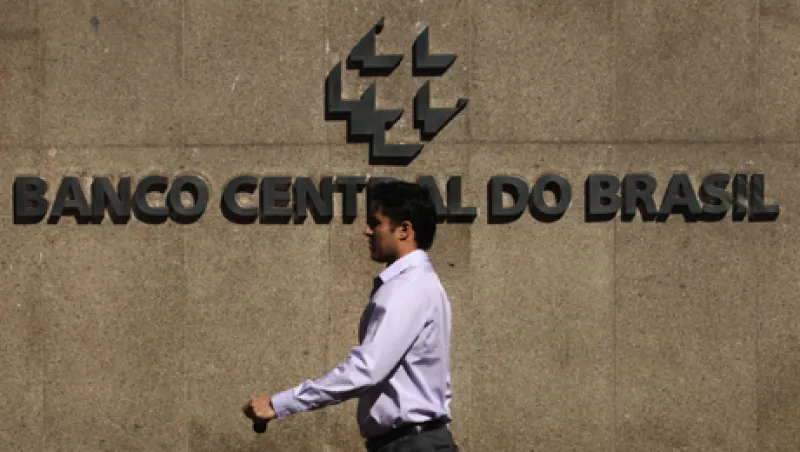Brazil has been unable to shake off its reputation as a “chicken flight economy,” as Latin America hands are wont to put it — an economy that soars for brief periods, but crashes again to the ground because it cannot sustain the momentum.
As a result, the São Paulo Bovespa stock index has shown much the same pattern. After a spectacular 70 percent rise in 2009, it has struggled to hold onto its gains, trading on Friday 19 percent below its late 2010 peak and only 4 percent up on the beginning of the year. A possible interest rate cut on Wednesday, after the Central Bank of Brazil’s monetary policy meeting, may give it a temporary boost. Nevertheless, analysts say that deep structural reform is required to give the market back its mojo.
Rising commodity prices and increasing financial and political stability enabled Brazil to take off from the mid-2000s after disappointingly low growth in the previous decade, which averaged only 2.5 percent — a level more appropriate for a developed than a developing economy. But after gross domestic product (GDP) growth peaked at a stratospheric 7.5 percent in 2010, the boom was brought to an end by a combination of slowing global trade and the central bank’s imposition of tight monetary policy to rein in inflation.
Brazil’s essential problem is that it has not yet convincingly proved that it is more than a commodity economy that rises and falls with acute sensitivity in response to changes in global commodity demand — in particular the agricultural commodities such as coffee, oranges and sugar cane in which Brazil specializes. A consumer boom fueled by lower interest rates helped to disguise this weakness for a while by boosting domestic demand. However, this is showing signs of flagging, despite a rapid unwinding of the interest rate hiking by the central bank, which has brought the cost of borrowing back down to 7.5 percent.
Economists predict no more than a final 25bp cut in interest rates — perhaps this week, perhaps in late November — so there is little impetus left to continue spurring consumer spending. In any case, the rise in the debt burden will make consumers reluctant to dig into their pockets. A July report on Brazil by the International Monetary Fund found that households are spending almost a quarter of their income on servicing debt, more than in other large Latin American economies and considerably more than in the U.S. The report added, “Moreover, recent credit and delinquency trends suggest that some segments of the household sector may already be under stress.”
The government responded to the economic slowdown in August with a $66 billion stimulus package but this, too, can only prove a temporary solution. Government debt-to-GDP is a little above 60 percent: a relatively healthy level, but one that leaves little room for increases if the government wants to avoid future fiscal headaches.
Critics of Brazil’s economic management regard much of its past growth as “bad growth” — higher growth that would have to be compensated for with lower growth some years down the line, as households pared their debt back to safe levels. What Brazil needs now, they can argue, is “good growth”: an increase in the long-term, underlying rate fueled by supply-side reforms that allow the economy to expand for longer before becoming stuck in bottlenecks.
One of the tightest bottlenecks is what Brazilians call the “custo Brazil,” or “Brazil cost,” the unofficial name for the extra financial burden of doing business in the country. In particular, Brazil’s infrastructure is weak, with container ships held up for days at ports because of a lack of capacity. The stimulus package is, sensibly, targeted at infrastructure, including highways and railroads as well as harbors.
However, Brazil’s most necessary reform is also perhaps the hardest and certainly the slowest-acting, since the full effects will not be felt for decades even if reform succeeds.
Brazil has a bad education system by the standards of middle-income countries, despite recent efforts by the government to improve the quality of teacher training. National studies show low levels of reading ability among school children in Portuguese, the country’s main language. The prestigious Pisa tests of teenage education published by the Organization for Economic Cooperation and Development show that Brazil performs poorly compared with much of the rest of the world — though no worse than some of its equally lackluster Latin American neighbors. Mediocre education has kept average annual productivity growth at only 1.5 percent over the past decade, compared with about 4 percent in China according to some estimates.
An improvement in education standards would address the common complaint among international employers in Brazil that it is hard to find suitably qualified staff — a shortage which bids up the wages of those who are qualified, contributing to Brazil’s status as a country with high underlying inflation and high interest rates. It would also raise Brazil’s underlying growth rate for decades, as more educated young people gradually entered the labor force, replacing retiring workers who have poorer education. It would, therefore, produce the ultimate in “good growth” — giving a fillip to noninflationary expansion for decades, regardless of global commodity booms and busts. This might, perhaps, enable the Brazilian economy to glide with the smoothness of a condor — though that is probably too much to expect for any stock market.






